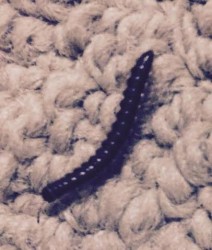Tag: segmented worms annelida
Worm with Antennae is a Millipede
“What kind of worm-like thing is this?” asks Evey in her submission regarding the segmented creature pictured below. “It has antennae and no legs. I found it burrowing in my ear.” To start with, we want to express our sympathy to Evey: it must be an unnerving experience to have any kind of creature burrowing into one’s ear. Now, given that this creature was found on/in Evey, we cannot provide an identification with 100% certainty or accuracy, because there is a chance that the discovery of this organism has medical implications. So, what we can do is direct Evey to some resources were she to grow concerned for her health as a result of finding this creature, and we can also provide an identification that should only be considered if a medical professional does not identify any medical issues (and does identify the worm-like creature as a threat) or if Evey is not concerned for her health as a result of this discovery.
Earthworms Emerge Through Concrete Patio: How to Control Their Populations
“Earthworms keep pushing the grout up, breaking the seal” says this reader about the creatures who have been emerging from “between the slabs” of his concrete patio in his backyard. Our reader asks us if we know how he can get the worms to “get out from under the slabs.”
Bright Red Worm Found in Toilet is an Oligochaete
A red worm was found in the toilet by one of our readers one night. This red worm appears to have sheer skin, is quite long and has a thin body, and our reader asks that we identify it for them.
Inch-Long Tan Worms in Florida Apartment are Most Likely Millipedes
A reader recently sent in a query about finding live, big worms in her small, ground-floor apartment in Florida, as well as very small and thin worms that follow them inside. The smaller worms are apparently about an inch in length, “a drop thicker than a needle”, and tannish in color.
Outrageous Infestation of Small Brown Worms Are Millipedes!
A reader concerned about an “outrageous infestation” of small brown worms outside her home sent in this image below of a small worm with a triangular tipped tail and a brown, ridged body.
Segmented Worms, of the Annelid Phylum
The annelids are a large phylum of segmented worms; consequently, annelids are commonly called simply “segmented worms.” (They are also, by the way, called “ringed worms,” as the worms’ segmented bodies often make them look like they are wrapped in small rings.) There are over 17,000 species in the annelid phylum, according to recent research, and while this is far less diverse than the phylum Nematoda, which is estimated to have approximately 1,000,000 species, the annelids are still extremely diverse relative to other species of animals.
The Evolution of Worms
A reader recently wrote to us inquiring about the evolution of worms. He asked several specific questions about the evolutionary history of worms, not all of which we can answer, but we can sketch a picture, even if incompletely, of the evolution of worms.
Most Common Types of Segmented Worms
At last count, there were more than 9,000 species of segmented worms on the planet today. Some of the most common types of segmented worms include earthworms, leeches, and sandworms.
Segmented Worm Types
The earthworm is by far the most vast and varied group of segmented worms on the planet. Just think, there are more than 2,700 different types of earthworm living in every corner of the earth today.
What Do Worms Eat?
Worms feast on dirt as well—especially if they live deeper inside the earth than the norm. Worms also eat plants, fruits, and antioxidant rich vegetables.
Worm Digestive System: How Does It Work?
When the worm eats its food, it pulls the materials into its mouth with the help of the pharynx and its prostomium, also called “acron”.
Different Types of Worms
There are literally thousands of different types of worms on the earth. Some can be found in just about any garden or backyard, while others may be found buried beneath the sand on hundreds of beaches overseas.
Limb Boring Worm
The limb boring worm tunnels into hard materials such as rocks and shells. While you may never witness a boring worm in action, you may notice their bodies sticking out of mollusk shells and rock cracks after they have tunneled through.









